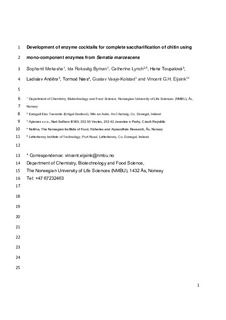| dc.contributor.author | Mekasha, Sophanit | |
| dc.contributor.author | Byman, Ida Roksvåg | |
| dc.contributor.author | Lynch, Catherine | |
| dc.contributor.author | Toupalová, Hana | |
| dc.contributor.author | Andera, Ladislav | |
| dc.contributor.author | Næs, Tormod | |
| dc.contributor.author | Vaaje-Kolstad, Gustav | |
| dc.contributor.author | Eijsink, Vincentius Gerardus Henricus | |
| dc.date.accessioned | 2018-05-03T07:24:09Z | |
| dc.date.available | 2018-05-03T07:24:09Z | |
| dc.date.created | 2017-05-30T11:25:22Z | |
| dc.date.issued | 2017 | |
| dc.identifier.citation | Process Biochemistry. 2017, 56 132-138. | nb_NO |
| dc.identifier.issn | 1359-5113 | |
| dc.identifier.uri | http://hdl.handle.net/11250/2496881 | |
| dc.description.abstract | One potential strategy for biorefining of chitin-rich biomass entails enzymatic saccharification, which, so far, has been scarcely explored. Here, saccharification of chitin was explored using response surface methodology available in the MODDE®10 software, to develop optimal cocktails of five mono-component enzymes from Serratia marcescens, three chitinases, SmChiA, SmChiB, SmChiC, a lytic polysaccharide monooxygenase, SmLPMO10A (or “CBP21”), and a beta-N-acetylhexosaminidase, SmCHB (“chitobiase”). These five enzymes were recombinantly produced in Escherichia coli. For both shrimp and crab chitins, SmChiA was the most abundant (40% and 38%, respectively) in the optimized cocktails, whereas SmChiB, SmChiC and SmLPMO10A were present at 30% and 26%, 15% and 23%, and 3% and 2%, respectively. Saccharification yields were 70%–75%, whereas a “minimal” cocktail of SmChiA and SmCHB gave only 40% saccharification. These results show that enzymatic saccharification of chitin requires multiple enzyme activities applied at dosages similar to those used for saccharification of cellulose. | |
| dc.language.iso | eng | nb_NO |
| dc.rights | Attribution-NonCommercial-NoDerivatives 4.0 Internasjonal | * |
| dc.rights.uri | http://creativecommons.org/licenses/by-nc-nd/4.0/deed.no | * |
| dc.title | Development of enzyme cocktails for complete saccharification of chitin using mono-component enzymes from Serratia marcescens | nb_NO |
| dc.type | Journal article | nb_NO |
| dc.type | Peer reviewed | nb_NO |
| dc.description.version | acceptedVersion | |
| dc.source.pagenumber | 132-138 | nb_NO |
| dc.source.volume | 56 | nb_NO |
| dc.source.journal | Process Biochemistry | nb_NO |
| dc.identifier.doi | 10.1016/j.procbio.2017.02.021 | |
| dc.identifier.cristin | 1472737 | |
| dc.relation.project | Nofima AS: 201702 | nb_NO |
| dc.relation.project | Norges forskningsråd: 262308 | nb_NO |
| dc.relation.project | Norges forskningsråd: 221576 | nb_NO |
| dc.relation.project | EC/FP7/FPR7-289284 | nb_NO |
| cristin.unitcode | 192,12,0,0 | |
| cristin.unitname | Kjemi, bioteknologi og matvitenskap | |
| cristin.ispublished | true | |
| cristin.fulltext | postprint | |
| cristin.qualitycode | 1 | |

